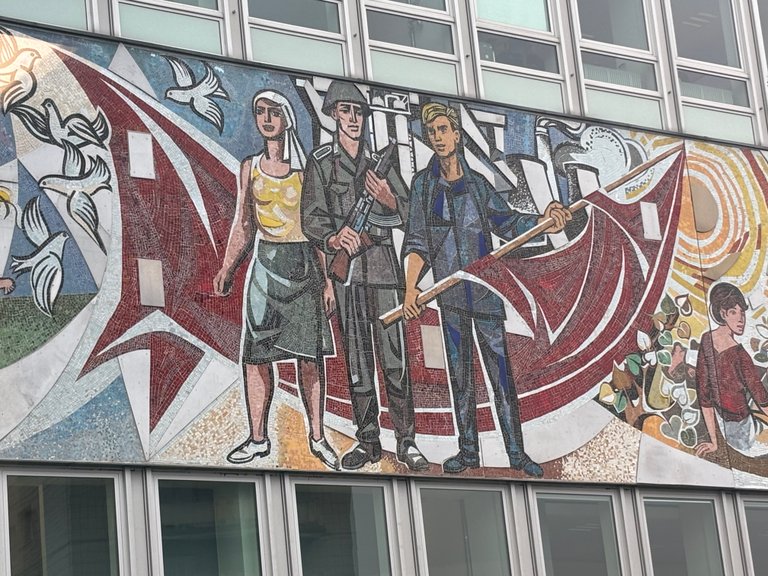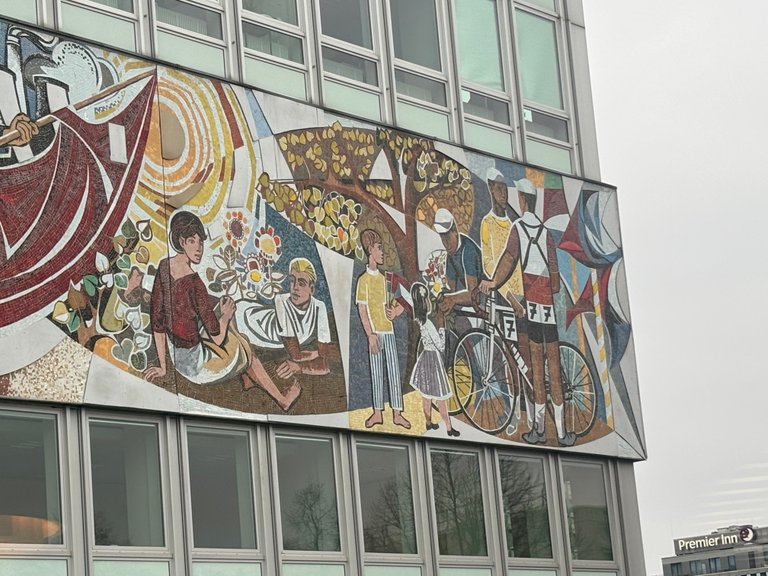A Mural at Alexanderplatz: Art in the Service of Ideology?

If you stroll through Berlin’s Alexanderplatz, you’ll quickly notice the large mosaic on the side of the Haus des Lehrers (House of Teachers). It shows workers, soldiers, and intellectuals in proud, powerful poses — a classic example of socialist realism, the official art style of the former East Germany (GDR).

📍 The Location: Haus des Lehrers
The “Haus des Lehrers” was built in the 1960s as part of the socialist redevelopment of East Berlin’s city center. It wasn’t just meant to be an administrative building but also a symbol of socialist education and progress.
The 125-meter-long, 7-meter-high mural, titled “Unser Leben” (Our Life), was created by artist Walter Womacka. Composed of over 800,000 colored tiles, it depicts scenes from everyday life in the GDR — work, science, education, and community life — all with a strong dose of optimism and ideological purpose.
⸻
🎨 Socialist Realism – Art with a Mission
The people in the mural appear strong, confident, and harmonious — they embody the ideal of the “new socialist human.” This style reflects the principles of socialist realism, an art doctrine developed in the Soviet Union and adopted by all Eastern Bloc countries from the 1930s onward.
Socialist realism demanded that art be accessible, optimistic, and aligned with party values. It wasn’t about personal expression, but about collective uplift and glorifying socialism.
⸻
⚠️ When Art Becomes a Tool of Power
As visually stunning as the mosaic is, it stands as a reminder of how art can be used as a political tool. The figures aren’t individuals — they are ideals. There’s no room for doubt, struggle, or dissent. Everything is perfect. Everyone knows their place.
In authoritarian regimes, art often isn’t free. It is guided, censored, and used to reinforce ideology. It tells a single story — the one approved by those in power.
Such art can shape minds, influence perceptions, and limit critical thought.
⸻

🧭 Why It Still Matters
Today, this mural is protected as a historic monument. And that’s important — not because we should blindly celebrate it, but because it serves as a reminder of a time when art was anything but free.
Public art always makes a statement. It influences how we see the world around us. And so we should look closely and ask questions: Who made this? Why? What message does it send?
Only then can we truly appreciate the past — and shape a more open future.
⸻
📸 Have you seen this mural at Alexanderplatz? What are your thoughts about it — art, propaganda, or both?
Let me know —
Cuao Kakao, your Morticia
🇩🇪 Wandbild am Alexanderplatz: Kunst im Dienste der Ideologie?

Wer über den Alexanderplatz in Berlin läuft, dem fällt früher oder später das monumentale Wandbild ins Auge, das sich an der Fassade des „Haus des Lehrers“ befindet. Es zeigt Arbeiter, Soldaten und Intellektuelle in kraftvoller, heroischer Pose – ein typisches Beispiel für den sozialistischen Realismus, wie er in der DDR propagiert wurde.
###📍 Der Ort: Haus des Lehrers
Das „Haus des Lehrers“ wurde in den 1960er Jahren gebaut und war eines der ersten Gebäude des neuen sozialistischen Alexanderplatzes in Ost-Berlin. Es sollte nicht nur ein Ort der Bildung und Verwaltung sein, sondern auch ein Symbol für die kulturelle und ideologische Ausrichtung der DDR.
Das 125 Meter lange und etwa 7 Meter hohe Mosaik an der Fassade wurde vom Künstler Walter Womacka entworfen. Es heißt „Unser Leben“ und zeigt in über 800.000 Mosaiksteinen Szenen aus dem Alltag der DDR-Bürger – mit einem klaren Fokus auf Arbeit, Fortschritt und Zusammenhalt.

⸻
###🎨 Sozialistischer Realismus – Kunst mit Auftrag
Die dargestellten Figuren wirken stark, selbstbewusst und harmonisch – ein Idealbild des „neuen sozialistischen Menschen“. Diese Darstellungsweise ist typisch für den sozialistischen Realismus, eine Kunstrichtung, die ab den 1930er Jahren in der Sowjetunion und später in allen Ostblockstaaten zur offiziellen Kunstform erhoben wurde.
Im Zentrum steht dabei nicht die individuelle Erfahrung, sondern der kollektive Fortschritt. Kunst sollte „volkstümlich, parteilich und optimistisch“ sein – also zugänglich für alle, ideologisch korrekt und ermutigend.
⸻
###⚠️ Wenn Kunst zum Sprachrohr der Macht wird
So beeindruckend die handwerkliche Ausführung dieses Mosaiks ist – es bleibt ein Mahnmal dafür, wie Kunst auch als politisches Instrument missbraucht werden kann. Die dargestellten Figuren sind keine realen Individuen, sondern Ideale. Es gibt keinen Platz für Zweifel, Kritik, Schwäche oder Vielfalt.
Solche Kunst verengt die Perspektive. Sie schreibt vor, was schön und richtig zu sein hat – und blendet das Menschliche oft aus.
Gerade in autoritären Systemen ist Kunst nicht frei, sondern wird gelenkt, kontrolliert und instrumentalisiert. Sie dient dann der Stabilisierung der Macht und nicht mehr der freien Auseinandersetzung mit der Welt.
⸻

###🧭 Warum wir hinschauen sollten
Heute steht das Wandbild unter Denkmalschutz. Es ist ein Zeitzeugnis – und gerade deshalb so wichtig. Denn es erinnert uns daran, wie Kunst im öffentlichen Raum auch Einfluss nimmt, formt und manipuliert.
Es liegt an uns, solche Kunstwerke nicht nur zu bewundern, sondern auch kritisch zu hinterfragen: Wer hat sie geschaffen? Warum? Und wofür?
Ciao Kakao,
Eure Morticia

Very interesting painting art, the beauty is very extraordinary. You can take some photos that are very important and focused. I really like it ❤️🙏
You can check out this post and your own profile on the map. Be part of the Worldmappin Community and join our Discord Channel to get in touch with other travelers, ask questions or just be updated on our latest features.